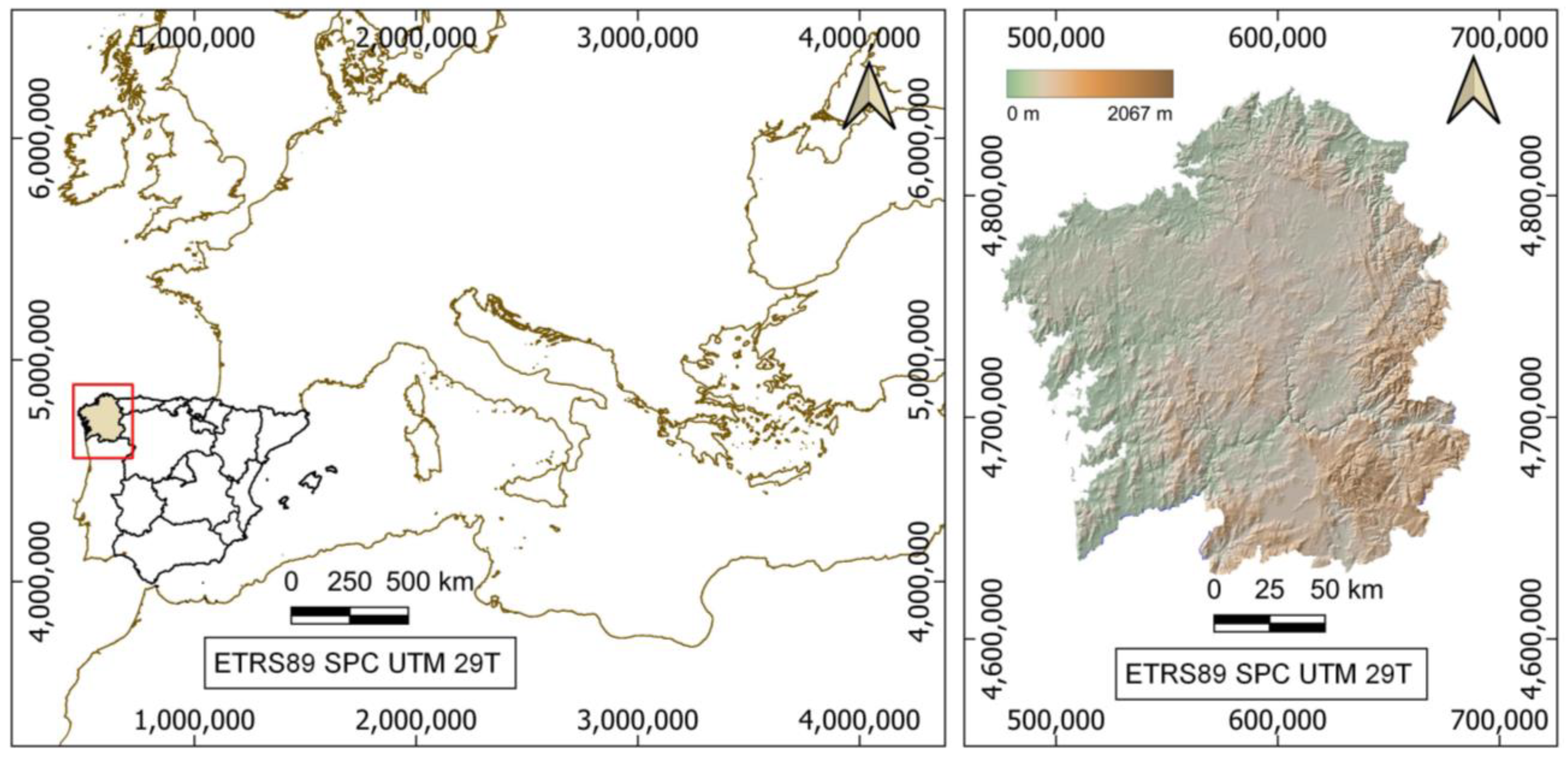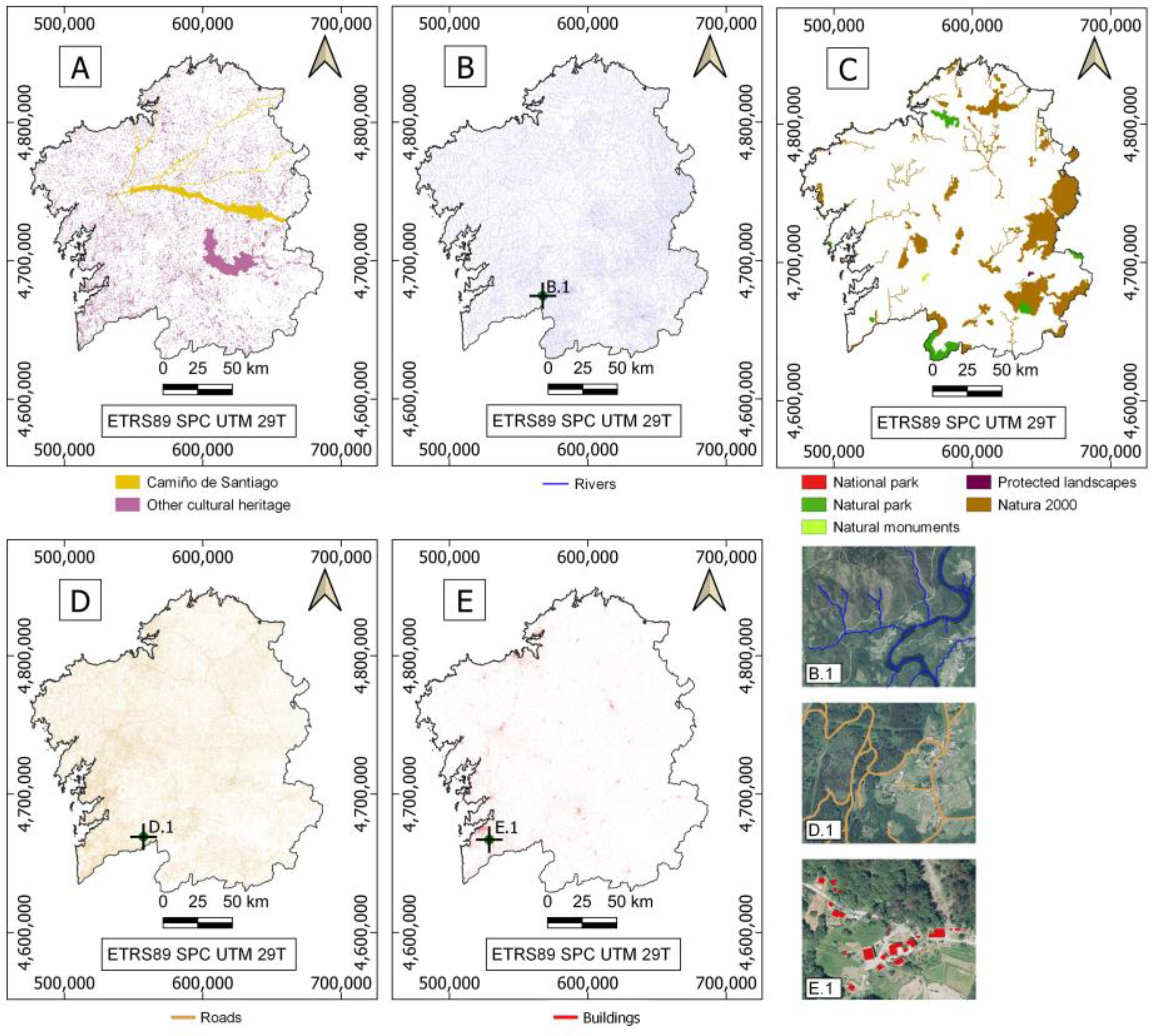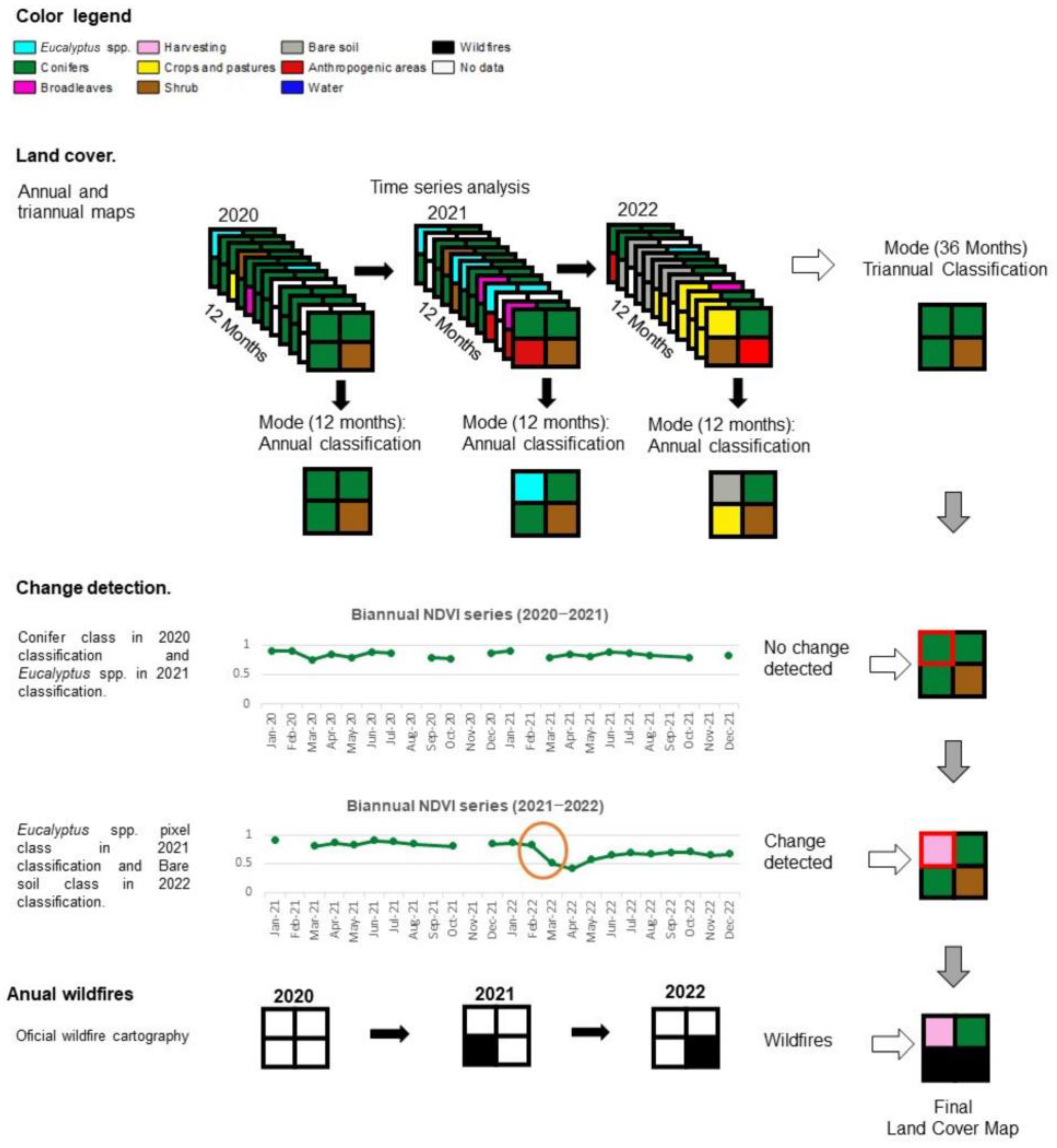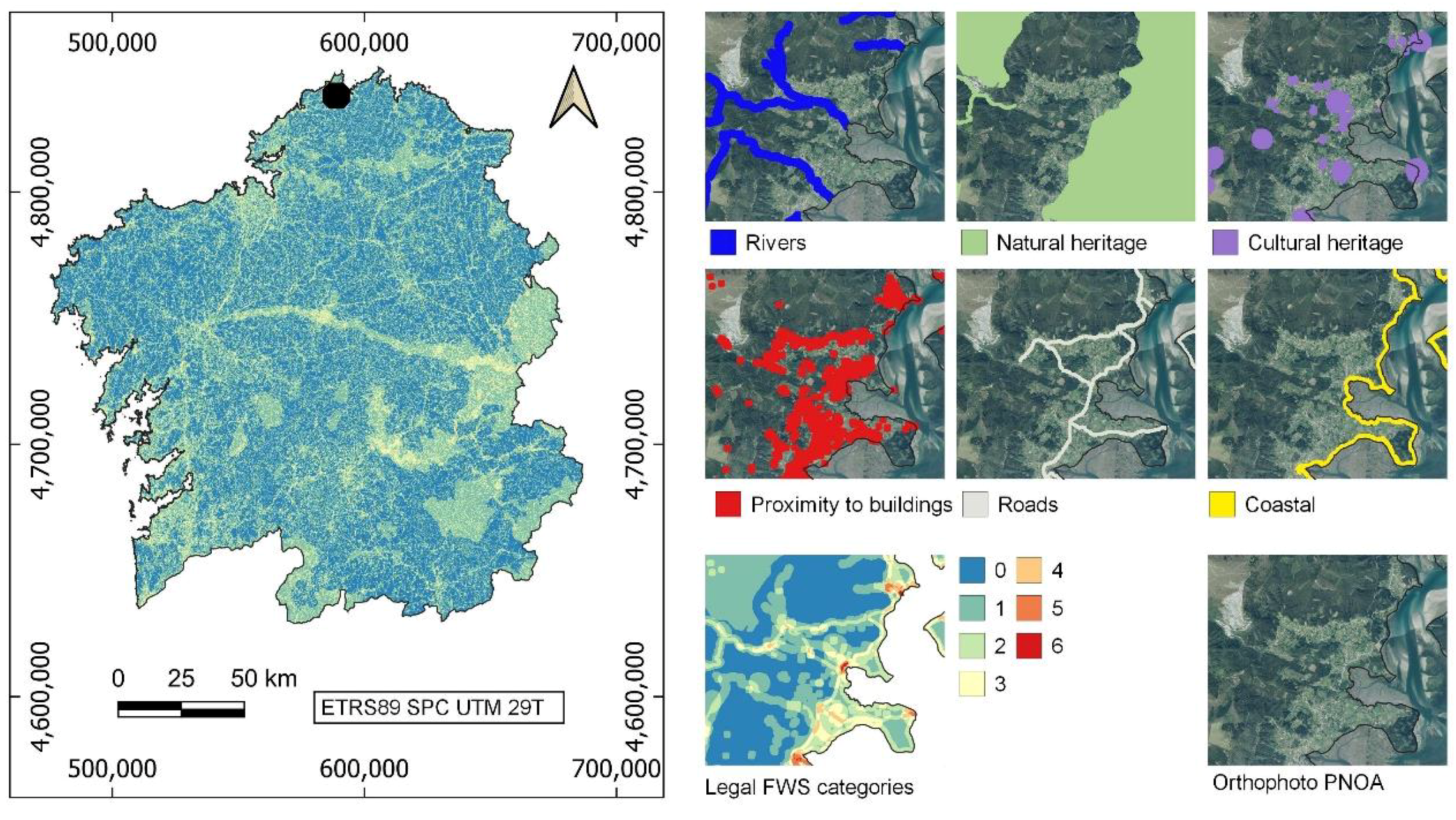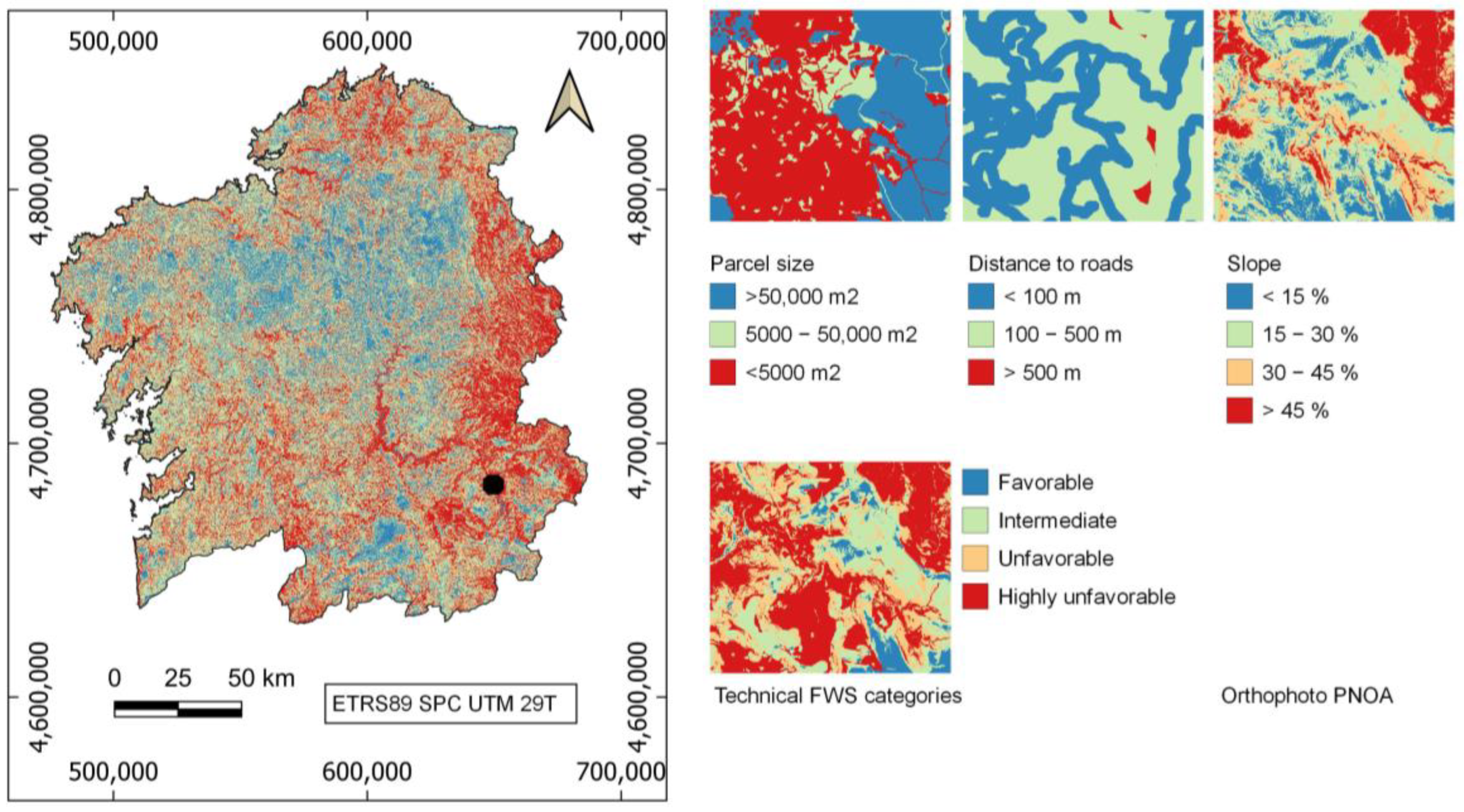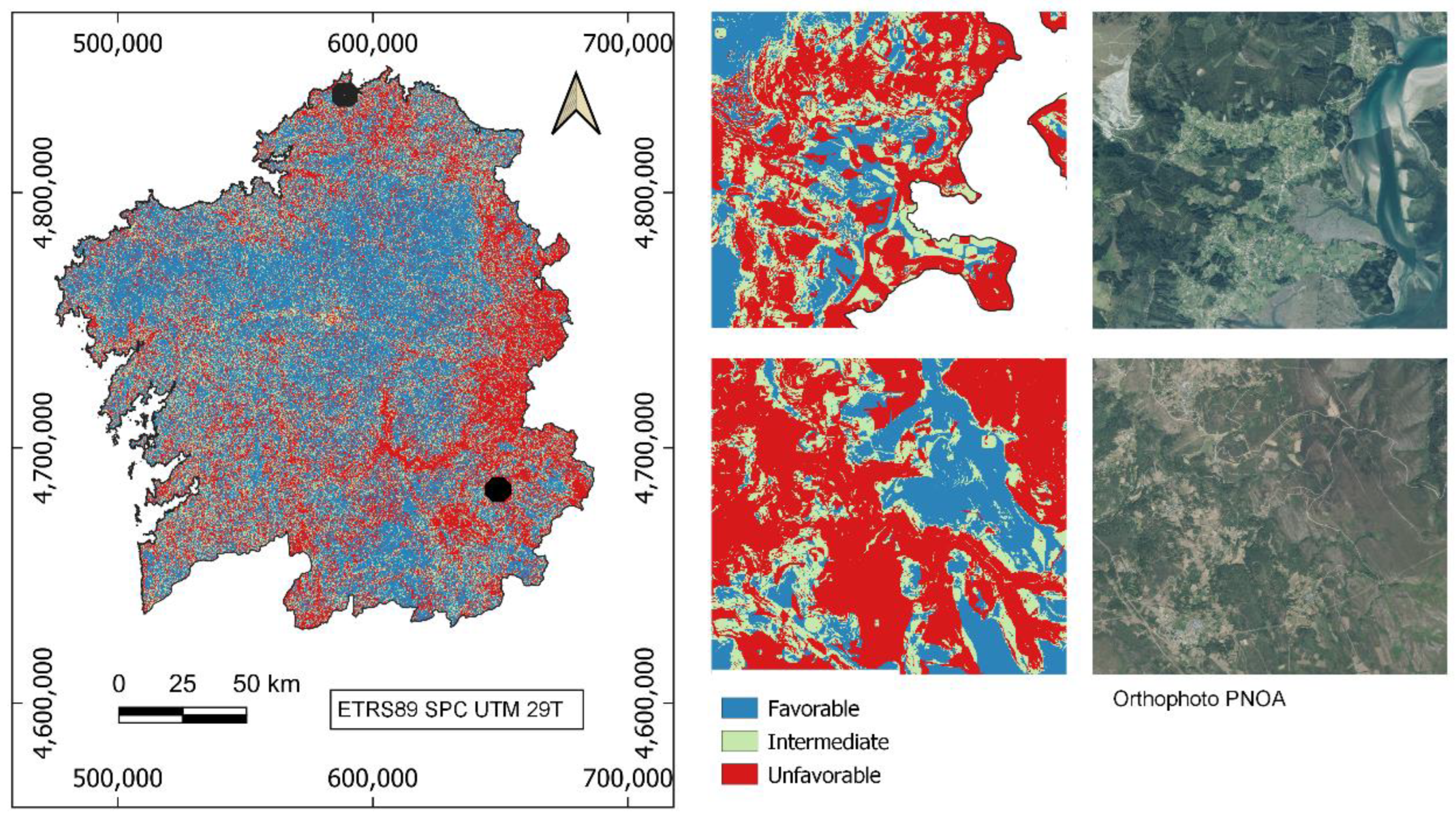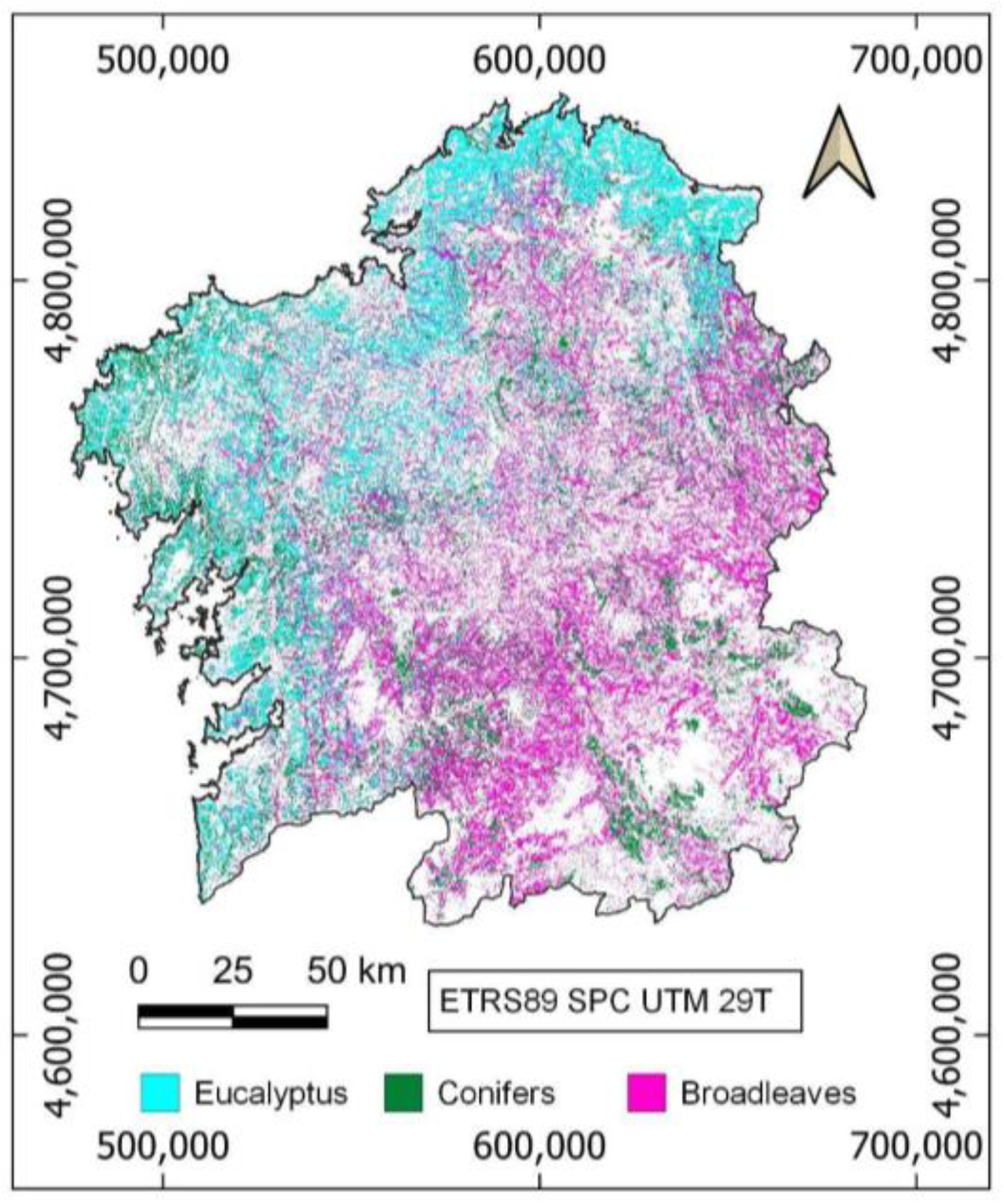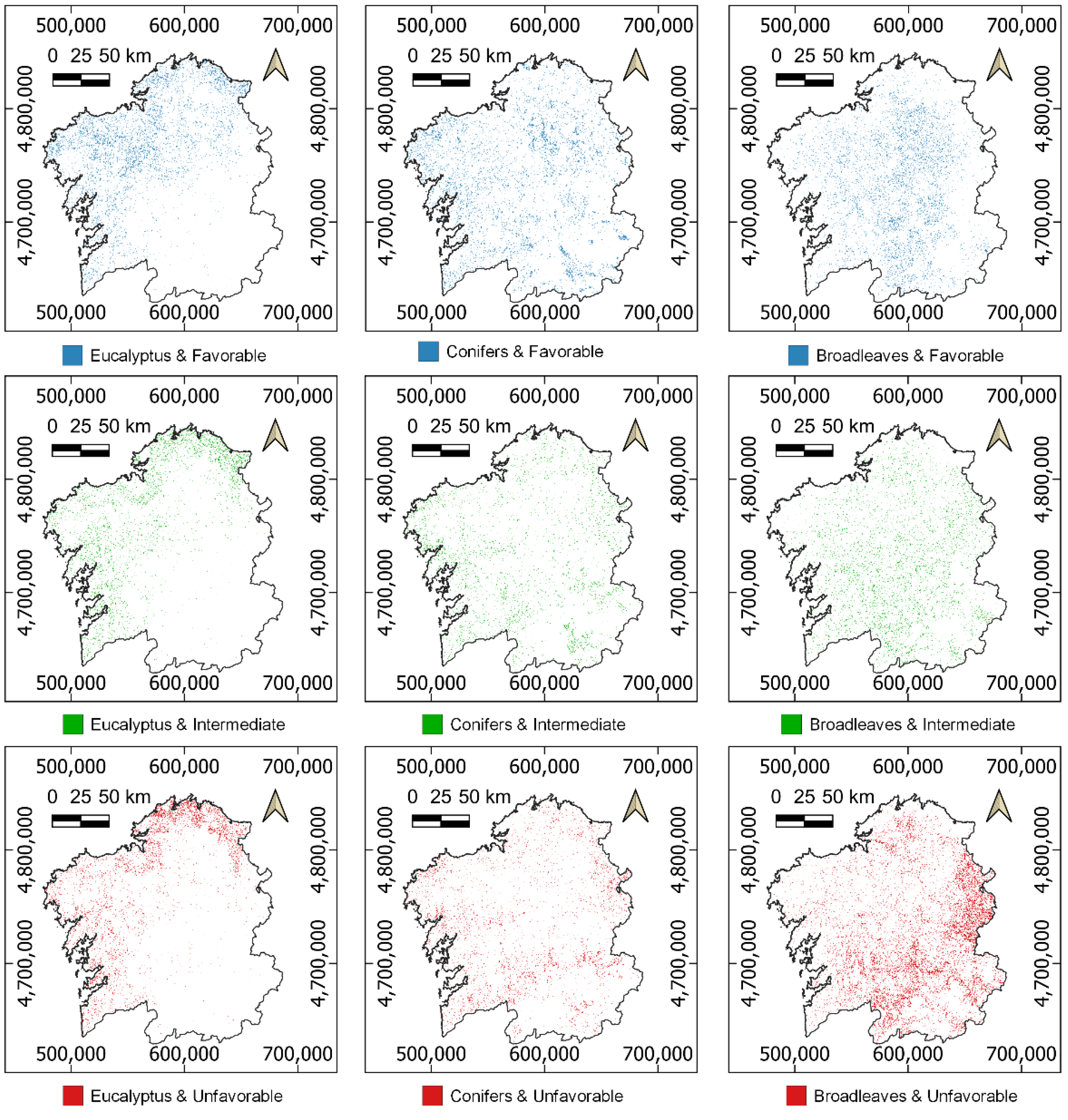1. Introduction
The transition to a climate-neutral economy has become a strategic goal for the European Union [
1], and as a consequence, wood and wood-based products are expected to gradually substitute fossil-based products and non-renewable resources in the coming years [
2]. This projected future increase in the demand for wood will require sustainable forest management policies [
3,
4], something which is also essential for ensuring other important ecosystem services like climate change mitigation, biodiversity conservation and cultural services [
1]. Sustainable forest management seeks to maintain and enhance the economic, social and environmental value of all types of forests, with the ultimate aim of benefiting present and future generations [
5]. To this end, having updated and complete information about the conditions of forest resource stocks is fundamental [
6]. Traditionally, forest inventories have focused on the geospatial distribution and characterization of forest resources in terms of their composition and the characterization of the stands [
7,
8]. However, knowledge of the constraints that might limit forest availability for wood supply (FAWS) or the feasibility for wood supply (FWS) of the resources present in a certain area is also crucial for implementing sustainable forest management policies [
9,
10].
According to Alberdi et al. [
9], there are three main types of constraints that affect wood supply: environmental constraints, social constraints and economic constraints. Environmental constraints refer to protected areas and landscapes, while social constraints include land uses where human activities limit the FAWS or the FWS, for instance, in military areas, heritage sites and game enclosures, among others [
11]. The identification of forested areas affected by environmental and social limitations can be performed through the identification of these land uses and the areas surrounding them that are affected by specific legal regulations. The primary legal restrictions that are considered in the literature are those that establish environmentally protected areas (i.e., strict reserves or national parks), hydrological protection areas, cultural heritage sites and areas related to the maintenance of physical goods and services (i.e., buildings and road setbacks) [
10,
11,
12,
13].
Economic constraints include market prices, cost-efficiency and the techniques used [
11,
14,
15]. Market prices may not be taken into account in the analysis of harvesting feasibility since they are subject to short-term fluctuations [
9]. Cost efficiency and extraction techniques, however, are closely related. According to Soman et al. [
16], extraction techniques and their costs outweigh the impact of other operational phases of harvesting in terms of importance for the overall cost-efficiency. The costs of the extraction techniques are determined by the performance and productivity of the forest machinery, and this depends greatly on certain technical restrictions that the terrain may present.
One of the technical restrictions that can significantly impact the performance of the harvesting systems is the slope of the terrain. Lundbäck et al. [
17] remark that the slope frequently determines the harvesting system that can be applied in a certain area. The slope also determines the productivity of some ground-based harvesting machinery: the greater the terrain slope, the lower the productivity of forwarders and skidders [
18]. Other technical factors that can limit harvest productivity are the size of the property and the distance from the extraction site to the closest road. The strong relation between forwarder productivity and the distance from the extraction site to the road was indicated by Proto et al. [
19] and Gagliardi et al. [
20]. Poje et al. [
21] and Verkerk et al. [
13] found that the size of the stand property can explain the forest harvesting intensity in a certain area. Despite these studies, it should be mentioned that it is difficult to establish clear threshold values for slope, distance to roads and property size in terms of their effects on wood availability and feasibility, since this can vary regionally [
10,
11]. For example, Ireland establishes a slope threshold of 30 degrees for the whole country [
22]. However, Spain defines different slope thresholds within the country, the limit being 45%–50% in all of Spain except for in the Atlantic region, where it is 75%–80% [
23].
In recent years, the National Forest Iinventories (NFI) in some countries have integrated parameters constraining the availability and feasibility of forests for wood supply. This is the case for the NFIs in Italy and Finland, which include data on forest ownership, infrastructures, conservation areas, cultural heritage sites and even wood availability [
24,
25]. The analysis of these variables is also performed at larger scales. This is the case for the study of Alberdi et al. [
11], which estimates the overall amount of forest area and above-ground biomass that is available for the wood supply of 13 European countries. Vauhkonen et al. [
14] is another example, providing harmonized projections of future forest resource availability in some European countries.
The systematic gathering of information related to legal and technical constraints has enabled the production of explicit maps of forests that are available or feasible for wood supply. For instance, Verkerk et al. [
26] provided wood production likelihood maps for European forests using a 1 km grid and considering legal and technical constraints. They observed that there were specific regions where the likelihood map differed greatly from the reality; this was the case in northwestern Spain and in southwestern France. Another example is the map created by Pucher et al. [
27], which provides an updated European map which identifies forests available for wood supply and feasibility of harvesting depending on the harvesting system that can be applied. However, the coarse resolution of this map (500 m grid) hinders its operational utilization at local and regional scales.
In this context, it is necessary to produce updated regional maps that report the feasibility for wood supply of the forest resources given the regional particularities. Additionally, given the increasing number of disturbances that are currently affecting forests (such as wildfires, windstorms or insect outbreaks) [
28,
29,
30], it may also be necessary to create methodologies that allow for feasibility information to be continuously updated to reflect the current forest cover.
This study performs a quantitative and geospatial analysis of the FWS for forests at a regional level and characterizes the current principal forest resources in terms of their FWS. The current legal constraints for forest management and the major economic constraints affecting wood mobilization in the study area were considered to determine the FWS. The study area is Galicia (in northwestern Spain), a region characterized by small holding regimes, high disturbance rates and some of the highest rates of wood production and harvesting intensity in Europe [
26,
31]. The methodology was designed to allow for the information to be continuously updated on an annual basis.
2. Case Study
This study was performed in Galicia, a region in northwestern Spain (see
Figure 1) that has a total surface area of 29,578 km
2 [
32]. In this region, forests play an important economic, social and environmental role. According to the latest official report by the regional forestry administration, 69% of the total surface area is covered by forests [
33] and 1.6% of the Galician gross domestic product (GDP) in 2019 corresponded to the Galician forest value chain [
34]. Galician forests are mainly composed of blue gum (
Eucalyptus globulus Labill.), shining gum (
Eucalyptus nitens (H. Deane & Maiden) Maiden), maritime pine (
Pinus pinaster Ait.), radiata pine (
Pinus radiata D. Don), scots pine (
Pinus sylvestris L.) and broadleaf species. Broadleaf forests are composed mainly of oak trees (
Quercus spp.) and sweet chestnut (
Castanea sativa Mill.) along with riparian species such as black alder (
Alnus glutinosa (L.) Gaertn) and willow trees (
Salix spp.). Ninety-seven percent of Galician forests are privately owned [
35]. Forest ownership is constituted principally by small-holding regimes, with roughly 40% of the Galician forest area being divided into cadastral parcels smaller than 0.5 ha [
36].
The main natural disturbance affecting Galician forests is wildfires. From 2018 to 2022, there were a total of 1499 wildfires in Galicia that were larger than 1 hectare; this is an annual average of 300 wildfires [
37]. They affected a total of 80,144 hectares of forest land, which accounts for almost 1% of forest area burned annually [
37]. Furthermore, this region has some of the highest levels of wood production and harvesting intensity in Europe [
26,
31]. According to the latest Spanish forest reports (from 2018 to 2021), Galicia harvests more than 50% of the total volume of wood harvested annually in Spain [
38]. This great incidence of harvesting and wildfires, coupled with small property sizes, make Galicia a region that is subject to frequent and ongoing forest changes. Meanwhile, Galicia is also involved in a land-abandonment process which, in some areas, increases forest land every year [
39]. As a consequence, gaining a comprehensive understanding of the feasibility of using forest resources for wood supply is especially challenging.
The Galician topography is characterized by plains, small mountains with steep valleys and a long coastline. Altitude ranges from sea level to mountains around 2000 m and the average altitude is 502 m [
40]. It has an average slope of 21%.
Figure 1 shows a hillshade of the digital terrain model of Galicia. The topography of the area along with a high rainfall result in a very dense hydrographic network in most of the Galician territory as shown in
Figure 2. In order to guarantee the environmental functions of riparian zones and coastal areas, they are subject to legal restrictions regarding the forest activities permitted [
41,
42].
Galicia has important cultural and natural heritage, as shown in
Figure 2. The cultural heritage sites are found both in populated areas and in forests. The natural protected areas include a national park (The Galician Atlantic Islands Maritime-Terrestrial National Park), six natural parks, eight natural monuments, two protected landscapes and several Nature 2000 areas [
43]. They cover a total of 398,497 ha [
44], of which 79% is forest surface [
38]. Performing any type of forest management in these areas requires special permission [
41]. The type of activities allowed, and the type of permissions needed, varies in each protected area and within each of them. This information is recorded in the management plan of each protected area.
Galicia is characterized by intense population dispersion. According to the latest data from the National Statistics Institute, Galicia is the region in Spain with the largest number of small villages and isolated constructions: 10,417 and 20,781, respectively [
45]. As a result, there is a very dense network of service and communication infrastructures, as shown in
Figure 2. In Galicia, the forest surrounding settlements, buildings and infrastructures is subject to forest management regulations aimed at wildfire prevention and ensuring the safety of infrastructures [
41,
46,
47].
4. Methodology
A flow chart of the methodology is provided in
Figure 3. The methodology followed to evaluate the FWS in forests in the study area includes the following steps:
Figure 3.
Flow-chart representing the followed methodology.
Figure 3.
Flow-chart representing the followed methodology.
4.1. Identification and Mapping of Restrictions
Any legal regulations that entail a certain limitation on forest management are considered to be legal constraints for FWS in the study area. This includes regulations that mandate special permissions or declarations of responsibility to perform forest management actions. A review of the regional law has revealed that there are legal restrictions affecting forestry management actions in the areas surrounding cultural heritage sites, rivers, coastal areas, buildings and roads. Environmentally protected areas are also affected by restrictions. Geospatial data sources were used to determine the location and extension of these areas. In some cases, the data sources include the surrounding areas that are affected by the restrictions; in other cases, simple geospatial operations were used to define the surrounding areas according to the specifications of the regulations.
The geodatabase used to map the areas surrounding cultural heritage sites and riparian zones that are affected by forest restrictions in the study area was the GDB20 [
41]. According to the Spanish law that regulates coastal areas, any type of exploitation taking place within 100 m (or greater than 100 m in some specific areas) of coastal boundaries requires special permission from the competent authority [
42]. The area affected by this law in Galicia is also contained in the GDB20 database. The areas affected by environmental protection were obtained from the ZEPVN geodatabase.
Special permission is needed when performing any type of forestry activity in the area surrounding roads [
47]. Different procedures have been required to map the boundary of the areas affected depending on the type of road. For regional roads, the area affected by forest restrictions is contained in the BTG20 database. In the case of national roads, the corresponding vector layer in the BTG20 contains only the layout; the surrounding area affected by forest restrictions was obtained by applying a buffer of 120 m to the vector layer.
The law that regulates wildfire prevention in Galicia defines specific limitations in the presence of certain tree species in proximity of buildings, and mandates the removal of all biomass of these species from these areas. This regulation involves limitations on the type of forestry management that can be applied in these areas. The area affected by this law was obtained by applying a 50 m buffer to the buildings mapped on the BTG20. A complete summary of the restrictions detected and the geodatabases used to identify them is presented in
Table 2.
The technical restrictions considered for the study correspond to the characteristics of the terrain that affect the cost-efficiency of wood supply. They were selected according to previous studies related to this topic and to the geospatial information available for the study area. The final restrictions selected were slope, distance to roads and parcel size. Slope was obtained from the SLOPE map. Distance to roads was defined as the Euclidean distance to potential loading areas. Highways were therefore not included in this analysis. The geodatabase used to characterize the territory according to this factor was BTG20. Parcel size was obtained from the CADASTRAL map, which contains information about the area of each parcel.
Table 2 compiles the selected legal restrictions and the geodatabases used to obtain them. It also shows the technical restrictions and the geospatial information used to characterize the land according to these restrictions. As a result of this process, a map is obtained for each of the restrictions affecting the FWS in the study area.
4.2. Harmonization of Formats of the Restriction Maps
The geospatial data sources used to detect the restrictions in the previous section are available in varying vector and raster formats. To harmonize them, the vector layers were transformed into raster layers, and the raster layers were resampled at a common spatial resolution that was fixed at a 10 × 10 m pixel size.
The geodatabases used to define the areas affected by legal restrictions are vector files. These vectors were rasterized into binary rasters, where pixels with a value of 0 correspond to areas that are not affected by any legal conditioning factors and pixels with a value of 1 correspond to areas affected by legal conditioning factors. This step was done using the Rasterize algorithm in the SAGA v7.8.2 tool [
56] in the Quantum Geographic Information Systems (QGIS) software v3.22.7 [
57].
Slope data are housed in a raster file with a 5 m resolution. To harmonize this information with the rest of the factors, this raster was resampled at 10 m using the resampling tool in SAGA v7.8.2 [
56] in the QGIS software v3.22.7 [
57]. The characterization of the land in terms of distance to roads was done by obtaining a 10 m raster where each pixel value represents the Euclidean distance from the central point of the pixel to the closest road (excluding highways and forest roads) appearing on the BTG20. This step was done using the Euclidian distance algorithm in ArcGIS v10.4.1 [
58]. Finally, a raster layer representing the parcel sizes is obtained. To build it, the CADASTRAL vector file was used. The digital value of every pixel corresponds to the area of the cadastral parcel to which the pixel belongs to. It was done using the Rasterize algorithm in the SAGA v7.8.2 tool [
56] in the QGIS software v3.22.7 [
57]. The spatial resolution of the layer is 10 m.
4.3. Categorization of Restrictions
The digital values of the technical restriction maps were transformed into categorical variables, as was done with the legal restrictions. The thresholds for each of the categories were defined according to the productivity and the operability of forest machinery according to previously published scientific studies [
23,
59]. Three homogeneous intervals of 15% slope amplitude were fixed below 45% and a fourth interval was established for values above 45%. The distance to roads was categorized into three intervals. Parcel size was categorized according to the distribution of the parcel sizes in the study area. Finally, the defined categories were assigned to one of the following qualitative FWS classes: favorable, intermediate, unfavorable or highly unfavorable (see
Table 3). The defined intervals and the corresponding qualitative classes for each restriction are presented in
Table 3.
4.4. Territory Characterization
All the rasters obtained in the previous step were aggregated to obtain a map that categorizes the land area according to FWS. This was done by combining the different restrictions using decision criteria. The entire study area was analyzed in this step, independent of whether woody cover was present or not. First, the legal restrictions were aggregated by summing the corresponding raster layers. As a result, a single raster was obtained containing the number of legal restrictions for each pixel. This raster was deemed the legal raster and represents the legal FWS.
The technical factors were combined following a set of decision rules. The first decision rule was defined to combine parcel size and distance to roads into a size–distance raster. They were combined to obtain a single raster with three feasibility classes (favorable, intermediate and unfavorable). The favorable class was assigned where the two categories coincided as favorable or where one was favorable and the other intermediate. The unfavorable class was assigned where the two categories coincided as unfavorable or where one was unfavorable and the other intermediate. The rest of the possible combinations were assigned to the intermediate category. A summary of the decision criteria is shown in
Table 4. Once the raster layer containing the area and distance to roads categories was obtained it was combined with the slope raster. A decision table was defined analogously to the previous one. A summary of the decision table used is shown in
Table 5. The resulting raster contains the aggregation of the technical variables; it is considered to be the raster layer that represents the technical FWS.
Finally, the legal and the technical feasibility maps were aggregated using decision criteria. The decision table used for this step is presented in
Table 6. As a result, one single raster layer is obtained that characterizes the land according to its FWS, independent of the current land cover.
4.5. Forest Resources Characterization
The characterization of the forests in the study area in terms of their FWS required an updated land cover map. For the study area, the Spanish cartography currently available in the study area cannot be considered updated given the dynamism of the Galician forests and the date of elaboration of the map: 2011 [
33]. Therefore, an updated map of the forest resources was elaborated using Sentinel-2 images from the period between 2020 and 2022. The following sections describe the procedure used to map the land covers in the study area and the procedure used to characterize forest covers in terms of their FWS.
4.5.1. Land Cover Mapping
The forest-oriented Sentinel-2 land cover map was elaborated through supervised classification with the aim of identifying the location of the main forest covers in the study area in 2022. The land cover map was obtained by combining two procedures: the first allows for the mapping of land covers that have remained undisturbed for a certain period of time (stable land covers) and the second allows for the mapping of land covers that present recent forest disturbances, mainly harvestings and wildfires.
The mapping of stable land covers was accomplished through supervised classifications according to the methodology described in Alonso et al. [
60], which was specifically designed to map forest covers in Galicia. The methodology consists of classifying monthly Sentinel-2 images using the random forest algorithm. The training data were collected disaggregating the main forest covers into
Eucalyptus forests, coniferous forests and broadleaf forests. A complete list of the thematic classes is shown in
Table 7. The time series in this study was 36 months (2020–2022) in order to ensure the detection of steady land covers. The whole set of monthly classifications are aggregated using decision criteria. The applied criterion consisted in assigning the most frequent land cover detected along the time series to a certain pixel [
61]. The resolution of the map was 10 m.
Forest disturbances were mapped separately. Harvest detection was performed following the methodology described by Alonso et al. [
62]. First, potential disturbance pixels were identified through the comparison of consecutive-year stable land cover maps. The consecutive year pairs analyzed were 2020–2021 and 2021–2022. Then, real disturbances were detected by analyzing bi-annual series of the NDVI index [
63]; specifically, the NDVI decision tree described by Alonso et al. [
62] was used to identify pixels that correspond to real changes and harvesting. Finally, wildfires were incorporated using the WILDFIRE database described in the
Section 3.1. All pixels within a wildfire polygon for the years 2020, 2021 and 2022 were classified as wildfire pixels on the final map. Both wildfires and harvesting were mapped at a 10 m resolution. An overview of the entire methodology used to generate the updated forest map is shown in
Figure 4.
The final map was verified using a random stratified sample of ground truth points. A total of 570 points per class were sampled. The harvesting class was verified separately for
Eucalyptus, conifers and broadleaves; the land cover map for the year 2020 was used for support. The ground truth of the points was obtained by analyzing the PNOA images presented in the
Section 3.3. A confusion matrix was created, and the following metrics were calculated: Overall Accuracy (OA), Producer’s Accuracy (PA), User’s Accuracy (UA), F-Score and Kappa Index. The ground truth of wildfires was not verified since the wildfire data come from an official data source.
4.5.2. Forest Characterization in Terms of FWS
Once the forest-oriented land cover map was obtained it was analyzed alongside the overall FWS map. Only the Eucalyptus, conifer and broadleaf tree covers were considered. They were studied in both numerical and spatial terms. First, percentages were obtained to represent the extension of each tree cover class in the obtained restrictions maps: the legal restrictions map, the technical restrictions map and the FWS map. Subsequently, the spatial distribution of each tree cover was obtained according to its FWS.
6. Discussion
This study describes a methodology to characterize forest resources according to their FWS considering specific regional needs and restrictions. The approach follows the current trend of the scientific community, which focuses on analyzing the availability of forest resources for wood supply from multiple perspectives. For instance, Fischer et al. [
10] focused on legal restrictions while Alberdi et al. [
11] and Vauhkonen et al. [
14] focused on monitoring FAWS according to economic, environmental and social factors. These kinds of studies provide useful information about which resources are available for harvesting and which are not. However, this study marks an advancement in that it incorporates all the constraints that affect in any way the wood supply for monitoring the FWS. This approach is of special relevance since, as Vauhkonen et al. [
14] indicate, wood supply projections can vary significantly depending on whether constraints that partially affect the wood supply are considered or not. As a result of the constraint analysis, compilation and aggregation, different categories of FWS are provided for the main forest resources, as well as a map with their geolocation. The resulting map represents an important aid for stakeholders in identifying priority areas for wood acquisition and the subsequent decision making.
An interesting map-focused approach was recently developed by Pucher et al. [
27]. They developed a map of Europe’s potential wood supply, differentiating between different harvesting systems. This map could be used as a proxy for wood supply feasibility. The comparison of their map with the one developed in this study reveals analogous results. For instance, the coastal area in the northeast of Galicia is mainly classified as unfavorable in this study; analogously, the map developed by Pucher et al. [
27] indicates that in this area the harvesting systems to be applied should be winch-assisted harvesters and winch-assisted forwarders, systems that are appropriate in steep areas where conventional forwarder operations are not technically feasible [
64]. It should be highlighted that the maps produced in this study have a higher spatial resolution than the map produced by Pucher et al. [
27]: 10 m versus 500 m. This increased resolution is essential for ensuring the implementation of the maps for forest management in a region dominated by small-holding tenure, and for allowing for appropriate decision-making at both the local and stand scales.
The methodology designed represents another interesting advantage in relation to other previous ones: the quantitative and qualitative results can be updated continuously. In contrast, the studies of Alberdi et al. [
11] and Vauhkonen et al. [
14], which are based on the existing NFI inventories, can only be updated when new editions of the NFI are released. Other studies such as the ones by Pucher et al. [
27] and Verkerk et al. [
13], which are based on Copernicus High Resolution Layers [
65] and Corine Land Cover products [
65], also depend on the updating of these products. Furthermore, although Copernicus High Resolution Layers are more frequently updated than the NFI, they only differentiate between broadleaf and coniferous forests [
65,
66], which can be insufficient in certain regions. This study reports the FWS corresponding to the main tree classes that are present in the study area. This is important since different types of trees are associated with different types of wood products [
67] and distinguishing between them can be essential for explaining variations in wood production [
13]. Finally, the incorporation in the final map of disturbances on an annual basis is essential when predicting forest availability for wood supply in a region like Galicia that is continuously subjected to disturbances, and has a large proportion of fast-growth species such as
Eucalyptus spp.
The categorization of the forest resources in Galicia according to their FWS show that broadleaves is the tree class with the largest area in the unfavorable category. This may be due to the fact that they commonly grow in mountainous areas and in areas with restrictions such as environmentally protected areas and riparian zones. In relation to the other tree classes,
Eucalyptus and conifers, the results reveal that the favorable category prevails. These are the main productive classes, according to regional forestry administration reports, that indicate that more than 95% of the annual harvested volume of timber in Galicia corresponds to Pinus spp. and
Eucalyptus spp. [
68]. In particular, roughly 60% of the total volume of wood harvested in Galicia each year is wood from
Eucalyptus spp. However, the area that is classified as unfavorable for
Eucalyptus spp. reaches 32%. Considering the difficulties that the mobilization of wood in unfavorable areas might entail, designing policies aimed at forest cover substitution in these areas might be considered.
Once the FWS is obtained for the whole region, further studies about wood supply can be accomplished. For this end, information of the forests stands like volume, tree density or management system will be needed. Nowadays these variables are not currently updated in the study area; the only source dates from 2011 (Spanish NFI [
33]) but it has not been generated in a geospatially explicit format. The Galician government has recently launched a project, together with Galician forest universities, to update the forest inventory information in this region [
69]. This project will provide detailed information on wood volumes and stand characteristics, among other outputs. Once the results are provided, combined analysis of updated inventory variables with the FWS maps will allow to generate wood supply reports in the study area.
The feasibility maps for the entirety of the study area represent an essential tool for designing land management actions and forest policies such as the design of regional afforestation and reforestation plans and the definition of the future role of the forests (either protective or productive). At a regional level, this could play a crucial role in the current tendency towards developing policies aimed at reducing the impact of climate change [
70]. Additionally, the maps can help improve land-use planning in an area subject to land abandonment and hence to forest expansion processes, as is the case in Galicia [
39] and in many other regions in Europe [
71].

